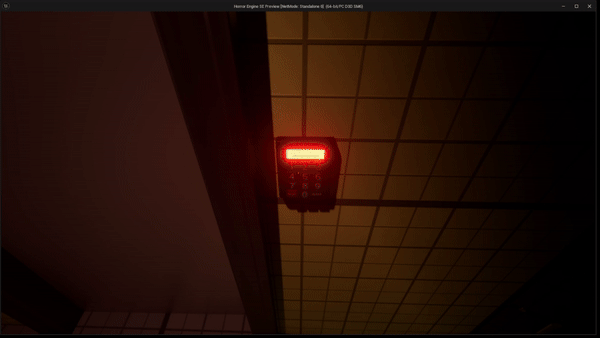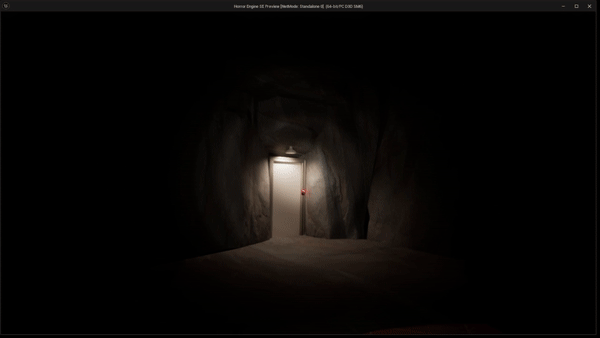

Echoes from the Anomaly is a first-person survival horror level inspired by Resident Evil Village and Amnesia.
Set in an abandoned military research facility this project seeks to blend atmospheric tension and environmental storytelling within the constraints of an overall narrative
Role: Level Designer
Platforms: PC
Engine: Unreal Engine 5
Team Size: 1
Tools Used: Figma, Whimsical
Marketplace Assets used: Blocking Starter Pack, Horror Engine SE
Location: Abandoned military research facility
Premise:
You assume the role of an urban explorer drawn to the mystery surrounding a rumored secret government research facility, believed by some to be abandoned your curiosity drives you to uncover the truth.
Key Features:
Atmospheric Exploration: Traverse the eerie tunnel and cave systems that hide remnants of the abandoned research facility.
Environmental Storytelling: Scattered documents and environmental clues reveal the facility’s tragic downfall and the experiments gone wrong.
For my pre-production phase, I focused a lot on gathering reference images.
These images influenced the overall structure, tone, and atmosphere I wanted to set for the level.
I focused on gathering concept art, real-world images, and in-game images.
To ensure that I was able to fit gameplay objectives and narrative beats within the game space I first started by creating simple top-down drawings to help me visualize the potential layout early on.
By utilizing various primitive shapes I was able to greybox various aspects of each area section by section.
After I had the basic layout set up I went back over each space one at a time and added some Identity features to help enhance gameplay testing. This allowed me to quickly and rapidly test each section's gameplay repetitively and with relative ease.
In Project Use:
The player walks across a wooden beam, after reaching the other side the beam breaks and falls into a pit. Thus trapping the player on the other side.
One-way valves Involve creating areas or passages that allow the player to move forward but prevent them from backtracking.
In horror games, this technique is crucial for building tension, as it limits the player's ability to retreat to familiar or safe areas. It forces players to confront new dangers and intensifies the feeling of being trapped or isolated.
By carefully placing these one-way elements (like collapsing floors, locked doors, or broken ladders), designers can control pacing, ensuring that players are consistently moving deeper into the unknown.
Privileged Position is where players are given a strategic view of their surroundings from an advantageous location, such as a high perch or a secure vantage point.
Tension Building:
By providing players with a vantage point that reveals the main research building I create a powerful moment of anticipation and dread.
Seeing the building from afar builds suspense and intensifies tensions as the players prepare to explore it.
Atmospheric Impact:
Presenting the main research building from a privileged position intensifies the building's eerie and enigmatic nature, deepening the immersive horror experience and making the players' eventual approach more unsettling.
In Project Use:
As the player moves through the level they come across an overlook. This overlook provides a view of the upcoming "Research Center" that players have heard about but not seen yet.
In Project Use:
The Player needs a passcode to continue, after exploring the nearby area they find a note that provides them with the passcode. They then can make their way back to the keypad, enter the code, and continue on.
Problem - Solution ordering involves presenting players with a challenge or obstacle (the problem) and guiding them to find a way to overcome it (the solution)
In horror games, this technique is vital for maintaining engagement and tension.
By introducing problems like a locked door players are forced to solve these issues by going to look for a way to unlock it in order to progress.
This process not only keeps them actively involved but also heightens suspense, as each problem solved brings them closer to uncovering deeper layers of what has unfolded within the research facility.
Affordance - refers to the intuitive cues that guide players on how to interact with objects or elements within the game environment. It involves designing elements so that their use or function is easily understood based on their appearance and context.
Vocab - involves creating and establishing a set of visual and interactive cues that players can learn to recognize throughout the game. This "vocab" helps players intuitively interpret the environment and interact with it effectively.
Clear affordance can enhance immersion by ensuring players aren’t confused or frustrated by unclear interactions. This allows them to focus on the atmosphere and narrative.
For instance, A giant glowing orb suddenly appears out of thin air might signal that it is interactive.
Vocab building is crucial for maintaining immersion and tension.
For example, certain items, colors, and visual effects consistently signify danger or interactivity.
In Project Use:
A Portal Spawns just when the player needs it to. This shows them its affordance and in turn, builds a vocabulary with them for any future interactivity of the mechanic.
In Project Use:
The Player walks into the first encounter room and the path forward is blocked by a locked door. Upon looking behind them they now can see a set of stairs that originally was blocked from their view when entering the room.
Presentation through Perspective involves controlling how players view and experience the game world by strategically placing gameplay information in such a way that the player can only see it from a specific angle.
In horror games, this technique shapes players' perceptions by controlling what players see and when. This creates suspense and enhances the atmosphere.
Effective use of perspective ensures that players remain engaged and invested in the horror experience.
By utilizing the Horror Engine marketplace pack I gained access to premade blueprint assets such as lights, locked doors, keycards, and more.
This allowed me to quickly set up key gameplay elements during my block-out phase, and iterate rapidly after playtesting each section. This saved me an immense amount of time and allowed me to focus on the overall flow, pacing, and timing of the gameplay mechanics.
I still had to set up the interaction triggers for each item as well as utilize overlap trigger functionality to properly set up the order of events that occurred during a horror scene.
Echoes from the Anomaly served as a perfect testing ground for me to explore a new level of quality when designing with gameplay and narrative in mind.
My major focus on this project was to effectively and quickly iterate on my design while keeping narrative and gameplay beats in mind. By using time-saving tools I was able to get right to the point of my project while also learning how to use a premade tool to help enhance my design process.
Furthermore, by utilizing a premade tool kit I was able to allow my creativity to flow and test different interactions quickly to find the right feeling based on the current design situation. This allowed me to focus on overall pacing and establish gameplay beats effectively.
I had a lot of fun working on this project and learned a lot about how to merge a narrative-driven experience with gameplay design and structure a level that encompasses both. Thank you for reading.











